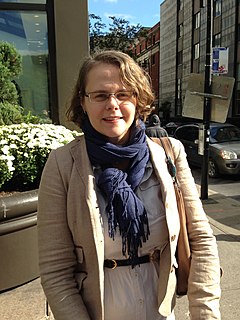Related Research Articles

Biopolymers are natural polymers produced by the cells of living organisms. Biopolymers consist of monomeric units that are covalently bonded to form larger molecules. There are three main classes of biopolymers, classified according to the monomers used and the structure of the biopolymer formed: polynucleotides, polypeptides, and polysaccharides. Polynucleotides, such as RNA and DNA, are long polymers composed of 13 or more nucleotide monomers. Polypeptides and proteins, are polymers of amino acids and some major examples include collagen, actin, and fibrin. Polysaccharides are linear or branched polymeric carbohydrates and examples include starch, cellulose and alginate. Other examples of biopolymers include natural rubbers, suberin and lignin, cutin and cutan and melanin.

Biodegradation is the breakdown of organic matter by microorganisms, such as bacteria and fungi.
Polymer chemistry is a sub-discipline of chemistry that focuses on the chemical synthesis, structure, and chemical and physical properties of polymers and macromolecules. The principles and methods used within polymer chemistry are also applicable through a wide range of other chemistry sub-disciplines like organic chemistry, analytical chemistry, and physical chemistry. Many materials have polymeric structures, from fully inorganic metals and ceramics to DNA and other biological molecules, however, polymer chemistry is typically referred to in the context of synthetic, organic compositions. Synthetic polymers are ubiquitous in commercial materials and products in everyday use, commonly referred to as plastics, and rubbers, and are major components of composite materials. Polymer chemistry can also be included in the broader fields of polymer science or even nanotechnology, both of which can be described as encompassing polymer physics and polymer engineering.

Polyhydroxyalkanoates or PHAs are polyesters produced in nature by numerous microorganisms, including through bacterial fermentation of sugars or lipids. When produced by bacteria they serve as both a source of energy and as a carbon store. More than 150 different monomers can be combined within this family to give materials with extremely different properties. These plastics are biodegradable and are used in the production of bioplastics.
Bioplastics are plastic materials produced from renewable biomass sources, such as vegetable fats and oils, corn starch, straw, woodchips, sawdust, recycled food waste, etc. Some bioplastics are obtained by processing directly from natural biopolymers including polysaccharides and proteins, while others are chemically synthesised from sugar derivatives and lipids from either plants or animals, or biologically generated by fermentation of sugars or lipids. In contrast, common plastics, such as fossil-fuel plastics are derived from petroleum or natural gas.

Biodegradable plastics are plastics that can be decomposed by the action of living organisms, usually microbes, into water, carbon dioxide, and biomass. Biodegradable plastics are commonly produced with renewable raw materials, micro-organisms, petrochemicals, or combinations of all three.

Biobased economy, bioeconomy or biotechonomy refers to economic activity involving the use of biotechnology and biomass in the production of goods, services, or energy. The terms are widely used by regional development agencies, national and international organizations, and biotechnology companies. They are closely linked to the evolution of the biotechnology industry and the capacity to study, understand, and manipulate genetic material that has been possible due to scientific research and technological development. This includes the application of scientific and technological developments to agriculture, health, chemical, and energy industries.
NatureWorks LLC is an international company that manufactures bioplastics—polymers derived entirely from plant resources—as an alternative to conventional plastic, which is made from petroleum. The commercial quality polymer is made from the carbon found in simple plant sugars such as corn starch to create a proprietary polylactic acid polymer (PLA) which is marketed under the brand name Ingeo. Headquartered in Minnetonka, Minnesota, NatureWorks is jointly owned by Cargill and PTT Global Chemical, a Thai state-owned company.

Plastics are a wide range of synthetic or semi-synthetic materials that use polymers as a main ingredient. Their plasticity makes it possible for plastics to be moulded, extruded or pressed into solid objects of various shapes. This adaptability, plus a wide range of other properties, such as being lightweight, durable, flexible, and inexpensive to produce, has led to its widespread use. Plastics typically are made through human industrial systems. Most modern plastics are derived from fossil fuel-based chemicals like natural gas or petroleum; however, recent industrial methods use variants made from renewable materials, such as corn or cotton derivatives.
Bioproducts engineering or bioprocess engineering refers to engineering of bio-products from renewable bioresources. This pertains to the design and development of processes and technologies for the sustainable manufacture of bioproducts from renewable biological resources.

Poly(3-hydroxybutyrate-co-3-hydroxyvalerate), commonly known as PHBV, is a polyhydroxyalkanoate-type polymer. It is biodegradable, nontoxic, biocompatible plastic produced naturally by bacteria and a good alternative for many non-biodegradable synthetic polymers. It is a thermoplastic linear aliphatic polyester. It is obtained by the copolymerization of 3-hydroxybutanoic acid and 3-hydroxypentanoic acid. PHBV is used in speciality packaging, orthopedic devices and in controlled release of drugs. PHBV undergoes bacterial degradation in the environment.
Yield10 Bioscience is a company developing new technologies to achieve improvements in crop yield to enhance global food security.
Isao Noda is a chemical engineer whose research has focused on polymer science and spectroscopy. He holds ninety patents granted in the United States and the EU, has published over three hundred articles, co-authored three books, and received a number of industry-wide awards and recognition for his contributions to his fields of research.
Karen L. Wooley is an American polymer chemist. She is a Distinguished Professor at Texas A&M University whose research focuses on developing novel polymers and nanostructured materials.

Danimer Scientific, formerly known as Meredian Holdings Group Inc. and MHG, is a biopolymer manufacturer headquartered in Bainbridge, Georgia.
Mubarak Ahmad Khan is a Bangladeshi scientist who has been doing research into Jute's commercial uses and possibilities. According to the science-based research database, Scopus, he is considered to be the leading scientist in the study of jute worldwide. He is currently serving as the Scientific Advisor of Bangladesh Jute Mills corporation (BJMC) Among his many discoveries citables are sonali bag, Jutin, helmets and tiles of which all are made from jute.

Audrey Moores is an Associate Professor of Chemistry and Tier II Canada Research Chair (2007-2017) in Green Chemistry at McGill University. She was named an emerging investigator in 2017 by the RSC journal Green Chemistry.
Sandra Pascoe Ortiz is a Mexican researcher and chemical engineer. She is a faculty member at the Universidad del Valle de Atemajac in Zapopan. Ortiz is known for developing a non-toxic, renewable, and biodegradable plastic alternative made from cactus juice.
Ipsita Roy is a British-Indian materials scientist who is a Professor at the University of Sheffield. Her research considers natural polymers of bacterial origin for medical applications. She was elected to the New York Academy of Sciences in 1997 and serves as the Editor of the Journal of Chemical Technology & Biotechnology.
References
- 1 2 3 "Eugene S. Stevens: Bioplastics, Biopolymers and Renewable Materials Research" Archived 2015-04-02 at the Wayback Machine Binghamton University. Jan. 8, 2013
- 1 2 3 Gies, Erica "Bioplastics: The challenge of viability" The New York Times, "Business." July 6, 2008.
- ↑ Kharif, Olga “From Nasty Bacteria to Eco-friendly Bugs” Bloomberg BusinessWeek. March 2, 2005.
- ↑ Gies, Erica “Beyond labels: Identifying the value of bioplastics” International Herald Tribune. July 7, 2008.
- ↑ "Green Plastics: An Introduction to the New Science of Biodegradable Plastics" Amazon Books. Accessed Feb. 15, 2015.
- 1 2 “Guide to Undergraduate Research 2014-2015: Faculty Research Interests" Binghamton University. Accessed Feb. 17, 2015.
- ↑ "Inside Binghamton University: Latest faculty research awards announced" Archived 2010-05-31 at the Wayback Machine Binghamton University. Accessed Feb. 17, 2015.
- ↑ Stevens. E.S. Green Plastics: An Introduction to the New Science of Biodegradable Plastics. Princeton University Press. Nov. 1, 2001
- 1 2 3 "Chancellor’s Award for Excellence in Faculty Service". Binghamton University. Oct. 17, 2011
- ↑ "The 'A' List." Believe! Binghamton University Foundation. Fall 2005